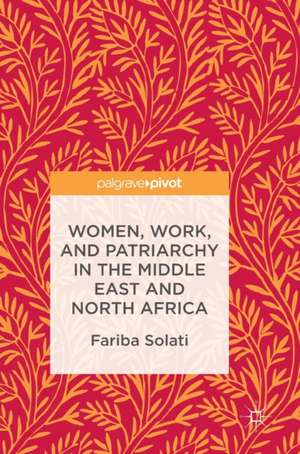Women, Work, and Patriarchy in the Middle East and North Africa
Autor Fariba Solatien Limba Engleză Hardback – 30 mar 2017
| Toate formatele și edițiile | Preț | Express |
|---|---|---|
| Paperback (1) | 411.32 lei 6-8 săpt. | |
| Springer International Publishing – 21 iul 2018 | 411.32 lei 6-8 săpt. | |
| Hardback (1) | 420.02 lei 6-8 săpt. | |
| Springer International Publishing – 30 mar 2017 | 420.02 lei 6-8 săpt. |
Preț: 420.02 lei
Nou
Puncte Express: 630
Preț estimativ în valută:
80.38€ • 87.28$ • 67.52£
80.38€ • 87.28$ • 67.52£
Carte tipărită la comandă
Livrare economică 23 aprilie-07 mai
Preluare comenzi: 021 569.72.76
Specificații
ISBN-13: 9783319515762
ISBN-10: 3319515764
Pagini: 118
Ilustrații: XXIII, 118 p. 3 illus. in color.
Dimensiuni: 148 x 210 x 14 mm
Greutate: 0.39 kg
Ediția:1st ed. 2017
Editura: Springer International Publishing
Colecția Palgrave Macmillan
Locul publicării:Cham, Switzerland
ISBN-10: 3319515764
Pagini: 118
Ilustrații: XXIII, 118 p. 3 illus. in color.
Dimensiuni: 148 x 210 x 14 mm
Greutate: 0.39 kg
Ediția:1st ed. 2017
Editura: Springer International Publishing
Colecția Palgrave Macmillan
Locul publicării:Cham, Switzerland
Cuprins
1. Introduction .- 2. Explaining the Low Rate of Female Labor Force Participation in the Middle East and North Africa .- 3. Measuring Patriarchy: The Determinants of Patriarchy in the Middle East and North Africa .- 4. Invisible Work of the Invisible Half: Women and 'Work' in the Middle East and North Africa .- 5. Conclusion.
Notă biografică
Fariba Solati is Assistant Professor in the Department of Economics at St. Thomas University, Canada.
Textul de pe ultima copertă
This book investigates why the rate of female labor force participation in the Middle East and North Africa is the lowest in the world. The author argues that the primary reason is the institution of patriarchy. By quantifying and measuring patriarchy across sixty developing countries over thirty years the book shows that MENA is in fact the most patriarchal region in the world.
Caracteristici
Marks an important and original contribution to the understudied field of women's work in the Middle East and North Africa (MENA) Compares MENA countries with other developing regions and examines the changes within these countries over three decades Draws from a vast pool of international datasets to analyze a topic that has historically lacked data to critically test hypotheses





